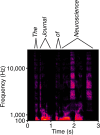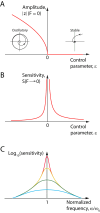The Critical Thing about the Ear's Sensory Hair Cells
- PMID: 39477536
- PMCID: PMC11529813
- DOI: 10.1523/JNEUROSCI.1583-24.2024
The Critical Thing about the Ear's Sensory Hair Cells
Abstract
The capabilities of the human ear are remarkable. We can normally detect acoustic stimuli down to a threshold sound-pressure level of 0 dB (decibels) at the entrance to the external ear, which elicits eardrum vibrations in the picometer range. From this threshold up to the onset of pain, 120 dB, our ears can encompass sounds that differ in power by a trillionfold. The comprehension of speech and enjoyment of music result from our ability to distinguish between tones that differ in frequency by only 0.2%. All these capabilities vanish upon damage to the ear's receptors, the mechanoreceptive sensory hair cells. Each cochlea, the auditory organ of the inner ear, contains some 16,000 such cells that are frequency-tuned between ∼20 Hz (cycles per second) and 20,000 Hz. Remarkably enough, hair cells do not simply capture sound energy: they can also exhibit an active process whereby sound signals are amplified, tuned, and scaled. This article describes the active process in detail and offers evidence that its striking features emerge from the operation of hair cells on the brink of an oscillatory instability-one example of the critical phenomena that are widespread in physics.
Keywords: auditory system; cochlea; gating spring; hair bundle; transduction; vestibular system.
Copyright © 2024 the authors.
Conflict of interest statement
The authors declare no competing financial interests.
Figures




Similar articles
-
The physics of hearing: fluid mechanics and the active process of the inner ear.Rep Prog Phys. 2014 Jul;77(7):076601. doi: 10.1088/0034-4885/77/7/076601. Epub 2014 Jul 9. Rep Prog Phys. 2014. PMID: 25006839 Review.
-
Phantom tones and suppressive masking by active nonlinear oscillation of the hair-cell bundle.Proc Natl Acad Sci U S A. 2012 May 22;109(21):E1344-51. doi: 10.1073/pnas.1202426109. Epub 2012 May 3. Proc Natl Acad Sci U S A. 2012. PMID: 22556264 Free PMC article.
-
Integrating the active process of hair cells with cochlear function.Nat Rev Neurosci. 2014 Sep;15(9):600-14. doi: 10.1038/nrn3786. Epub 2014 Aug 6. Nat Rev Neurosci. 2014. PMID: 25096182 Review.
-
Rapid mechanical stimulation of inner-ear hair cells by photonic pressure.Elife. 2021 Jul 6;10:e65930. doi: 10.7554/eLife.65930. Elife. 2021. PMID: 34227465 Free PMC article.
-
Mechanotransduction in mammalian sensory hair cells.Mol Cell Neurosci. 2022 May;120:103706. doi: 10.1016/j.mcn.2022.103706. Epub 2022 Feb 23. Mol Cell Neurosci. 2022. PMID: 35218890 Free PMC article. Review.
Cited by
-
Amplification through local critical behavior in the mammalian cochlea.Proc Natl Acad Sci U S A. 2025 Jul 22;122(29):e2503389122. doi: 10.1073/pnas.2503389122. Epub 2025 Jul 14. Proc Natl Acad Sci U S A. 2025. PMID: 40658842 Free PMC article.
-
Musical Hallucinosis: Auditory Illusions After Hearing Loss and Cochlear Implantation.Neurorehabil Neural Repair. 2025 Aug;39(8):677-681. doi: 10.1177/15459683251348171. Epub 2025 Jun 19. Neurorehabil Neural Repair. 2025. PMID: 40537459 Free PMC article. Review.
References
-
- Adachi N, Yoshida T, Nin F, Ogata G, Yamaguchi S, Suzuki T, Komune S, Hisa Y, Hibino H, Kurachi Y (2013) The mechanism underlying maintenance of the endocochlear potential by the K+ transport system in fibrocytes of the inner ear. J Physiol 591:4459–4472. 10.1113/jphysiol.2013.258046 - DOI - PMC - PubMed
Publication types
MeSH terms
LinkOut - more resources
Full Text Sources
Miscellaneous
